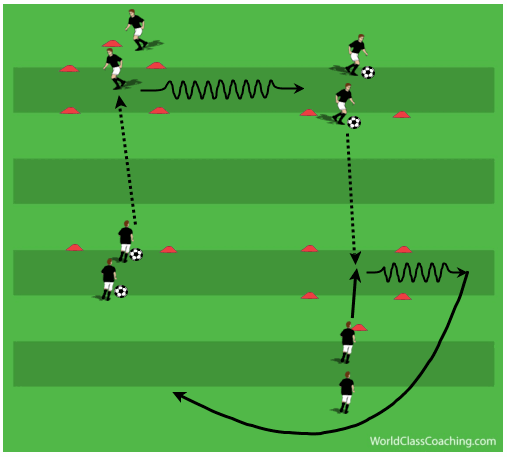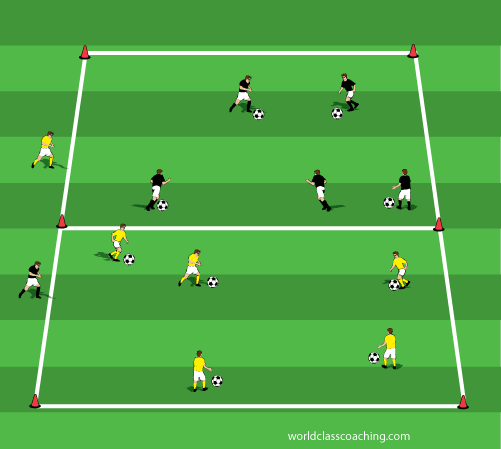Teaching players how to protect the ball until the option to shoot or pass is available is extremely important if you want your team to keep possession and learn to build an attack. There will be times when there isn't an open team mate and they need to buy some time and create some space before support arrives.
The first thing I do when working on this topic is to have the players focus on the quality of their first touch. A player's first touch can put them into a tackle or move the ball away from pressure. I use the following 'Cage' exercise to have the players focus on their first touch and moving it away from pressure.
The Cage
The player behind each of the two cages show into the middle and call for the ball. When the ball is passed they control it with their first touch and dribble out of the cage with their second touch. When they dribble out they should go out the side, not the front or back. Taking two touches and going out in a particular direction shows that the players have controlled the ball and can move away from pressure.
There are many variations and progressions that you can use with this basic exercise. You can ask the players to receive the ball with a certain surface, dribble out to the left, right or back of the cage. After the passer plays the ball they can be asked pressure the receiver to give them an opponent to move away from. The more advanced players you have the more you can challenge them with this exercise.
American Gladiators
This game puts the players under pressure to keep possession against an active defender. Two teams of six players are in their own 15 x 15-yard grid. One player from each team acts as a defender and enters the other team’s grid where the remaining five players are dribbling a ball. When a player’s ball is kicked out of the grid they are out of the game. The first defender to kick all of the balls out of the other teams grid, wins for point for their team. This is played six times so that everyone has a chance to act as the defender. This game promotes hard work from the defender and being strong on the ball for the girls who are trying to keep the ball.
As a progression, when a player's ball is kicked out they stay in the game and provide passing options for their team mates who are under pressure. Now the players focus on keeping the ball until they can find a pass to relieve the pressure. Eventually this turns into a game of keep away. As the players improve you can add more defenders or limit players to two touch once there is only one ball left.
Possession Game
Next we play a possession game. The number of players on each team and the addition of neutral players will depend on the age and ability of the players. The key is that each player is required to take at least three touches each time they receive the ball. This means that the defenders will have time to pressure them and they need to think and move quickly to protect the ball from the defenders. You can increase the number of touch as the players improve.
Small-Sided Game
We finish with a small-sided game with goals. The same rule is in effect. Putting the players in a game situation add the pressure of playing in a certain direction. I suggest that you remove the mandate of a certain number of touches for the last part of the scrimmage to see how the players apply the what they've learned during the session.
Have a great day!
Tom




